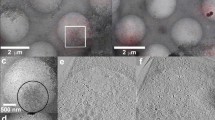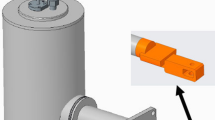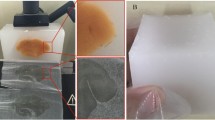Abstract
IN developing a satisfactory system for high-resolution autoradiography of soluble or unbound compounds1, we have investigated the possibility of frozen sectioning at low temperatures. At temperatures above −30° C adequate sections can be obtained for certain purposes, but in the temperature range commonly achieved in the standard laboratory cryostat, disruptive crystal formation limits the histological quality, and the thickness of the tissue section limits microscopic and autoradiographic resolution. At −20° C 4µ sections are difficult to prepare and the limit is about 2µ Optimal conditions for avoiding disruptive ice crystal formation obtain in the range of vitreous ice at temperatures below −130° (refs. 2–4). Above −130° C both cubic and vitreous ice may be converted into the stable hexagonal phase during which the individual crystals can grow to 10µ and cause membrane disruption5. The transformation occurs rapidly above −70° C and is pronounced at −60° C. In order to utilize the technique of frozen sectioning for dry high-resolution autoradiography, a method is required which will reduce the risk of ice crystal formation and which will provide thin tissue sections in the range of 0.5µ. to 1.0µ or lower.
This is a preview of subscription content, access via your institution
Access options
Subscribe to this journal
Receive 51 print issues and online access
$199.00 per year
only $3.90 per issue
Buy this article
- Purchase on Springer Link
- Instant access to full article PDF
Prices may be subject to local taxes which are calculated during checkout
Similar content being viewed by others
References
Stumpf, W. E., and Roth, L. J., Stain Tech., 39, 219 (1964).
Meryman, H. T., and Platt, W. T., Naval Medical Research Institute Report, 13, 1–30 (Jan. 3, 1955).
Luyet, B., Ann. N.Y. Acad. Sci., 85, 549 (1960).
Fernandez-Moran, H., Ann. N.Y. Acad. Sci., 85, 689 (1960).
Dowell, L. G., and Rinfret, A. P., Nature, 188, 1144 (1960).
Chang, J. P., Russell, W. O., Moore, E. B., and Sinclair, W. K., Amer. J. Clin. Path., 35, 14 (1961).
Author information
Authors and Affiliations
Rights and permissions
About this article
Cite this article
STUMPF, W., ROTH, L. Thin Sections cut at Temperatures of −70° to −90° C. Nature 205, 712–713 (1965). https://doi.org/10.1038/205712b0
Published:
Issue Date:
DOI: https://doi.org/10.1038/205712b0
Comments
By submitting a comment you agree to abide by our Terms and Community Guidelines. If you find something abusive or that does not comply with our terms or guidelines please flag it as inappropriate.



